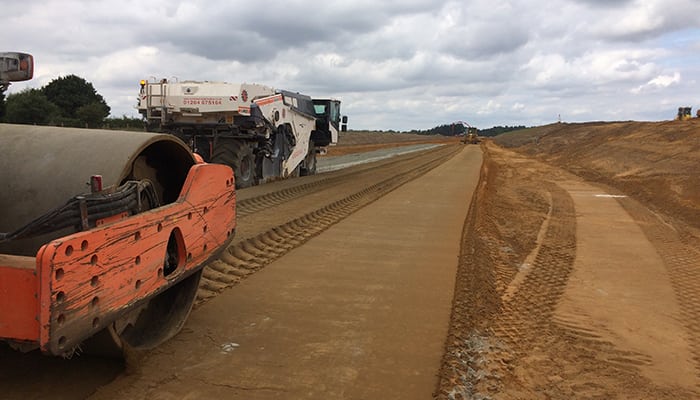Topcon Improves Accuracy of Earthworks Process on UK Carriageway Project
Jul 20, 2018 • Hardware • News • 3D Local Position System • Combined Soil Stabilisation Ltd • Infrastructure • field service engineers • field service management • Service Management • Topcon
Combined Soil Stabilisation Ltd increased the accuracy of the earthworks process using machine control technology on a major road project in East Anglia.
The project will see the development of a new 20km carriageway, stretching from the A47 in Postwick with Witton, east of Norwich, to the A1067 at Fakenham Road, north of Taverham. Once complete, the new northern development route will provide a semi-circle road around Norwich to help ease local areas of traffic congestion.
Combined Soil Stabilisation Ltd, a leading subcontractor within the soil stabilisation and earthworks industry, was appointed to stabilise the site won soils and prepare surfaces across the site ahead of the tarmac laying process. The team at Combined Soil Stabilisation Ltd needed equipment that would allow their graders to work to an extremely tight accuracy.
Before introducing the Topcon technology, we would have required engineers to be on the site, measuring and marking out with sticks, tape and ropesThe team, who were working near obstructions such as bridges and tunnels, which can cause barriers for GPS signals, also needed a system that can deliver precise positioning data even when signals may be blocked.
Combined Soil Stabilisation Ltd chose the Topcon 3D Local Position System (LPS) Robotic to be fitted to its graders. The LPS system uses an additional robotic total station and local networks to gather positioning data, allowing constant contact, accuracy and control for the machine operator.
“Before tarmac could be laid to create the topcoat of the road, the soil surface needed to be cut down and prepared within millimetres of accuracy. In this case, we were working to +/-10mm,” explains Stefan Stansfield, Managing Director at Combined Soil Stabilisation Ltd.
“Tarmac is an expensive material so it was vital that the soil surface was smooth and precise, to ensure that no additional product was needed to create a more even or level surface. Traditional methods of grading and GPS software we’ve used in the past would have made getting a tight trim tolerance of +/-10mm near impossible, as it wouldn’t have been accurate enough.
“Before introducing the Topcon technology, we would have required engineers to be on the site, measuring and marking out with sticks, tape and ropes. Instead, using the 3D LPS Robotic system on our Graders meant that we required less engineers to operate the machinery, saving us time, money and improving health and safety on site, as well as allowing us to work to the accuracy required. Topcon’s technology and equipment also helped to increase our efficiency on site and made the job much less labour intensive.
Work on the northern development route is still ongoing and will include the addition of two roundabouts and bridges to carry the dual carriageway over existing roads.
Stefan concluded: “The technology is definitely at the top end of the industry and Topcon has some of the most advanced local positioning systems that can be fitted to plant. Using the 3D LPS system in our Graders, we could instantly see where the machines were and check the level of trim tolerance. The equipment made it easy for us to save, not only in terms of time and money, but also on the amount of tarmac that could be wasted during the project.”
For more information about the Topcon technology used, please visit: www.topconpositioning.com/en-gb.
Be social and share




















 Field Service News is published by 1927 Media Ltd, an independent publisher whose sole focus is on the field service sector. As such our entire resources are focused on helping drive the field service sector forwards and aiming to best serve our industry through honest, incisive and innovative media coverage of the global field service sector.
Field Service News is published by 1927 Media Ltd, an independent publisher whose sole focus is on the field service sector. As such our entire resources are focused on helping drive the field service sector forwards and aiming to best serve our industry through honest, incisive and innovative media coverage of the global field service sector.
Leave a Reply